The Peoples of Tamriel: Humans
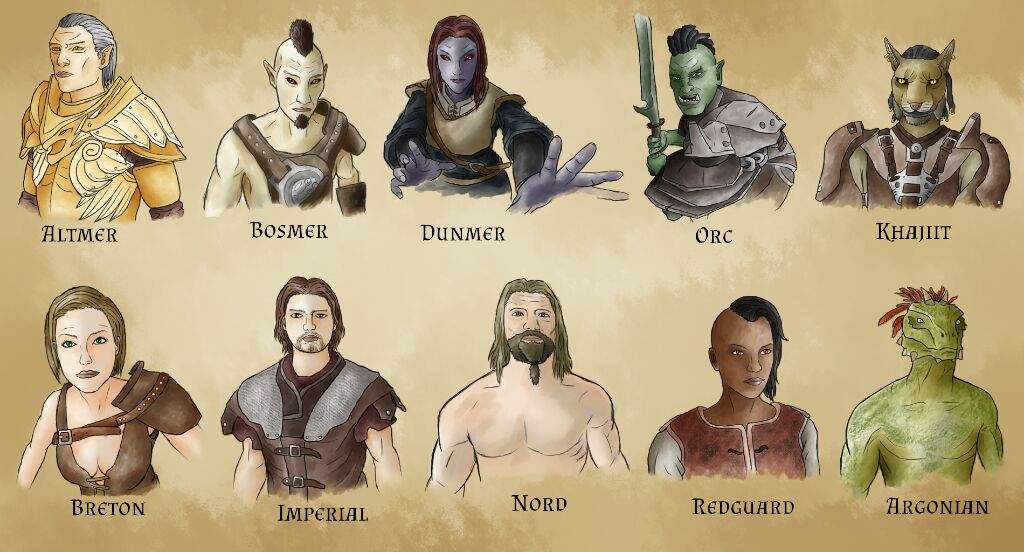
It appears someone finally took me up on my offer to write a more detailed post on any aspects of my One-Post Skyrim adaptation. The requested topic were racial templates, so this is what I’m going to write about it here.
Scholars in Tamriel tend to divide its peoples into three main classifications: “Men”, “Mer” and “Beast Folk”. This pretty much means Humans, Elves, and Everyone Else, and as usual for this kind of medieval-ish scholarship is as much a political construct as a biological one. This post deals with humans.
My primary source for this article are the wonderful Unofficial Elder Scrolls Pages, which have detailed descriptions of the lore and mechanics for all games in the franchise1.
Humans in Tamriel
Humans, being humans, don’t have any “mandatory” traits and as such their “templates” technically cost 0 points. Each of the human peoples described here is associated with a specific region of Tamriel where it makes up the majority of the population, so their descriptions also include a bit of info on those provinces and a small list of traits considered typical for their culture and common adventuring professions.
It’s entirely possible for a human character to not have any of their culture’s “stereotypical” traits, or to have an entirely different set more in line with the region they actually grew up in. And the list of common adventuring professions in no way restricts the professions a character may choose from. If you want to be a Nord Wizard or a Breton Ninja, go for it!
Bretons
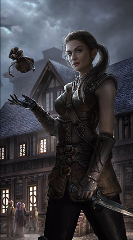
Bretons are humans native from the province of High Rock, the region of Tamriel that most resembles your typical Arthurian pastiche. They are commonly fair-skinned, with hair that ranges from black to blond. Many demonstrate a remarkable facility with (and resistance to) magic, which is alternatively attributed to their ancient druidic traditions or to elven blood depending on who’s doing the attribution.
The most common way for your average High Rock citizen to go up in life is to impress a noble from its many squabbling fiefs by performing meritorious deeds. High Rock is a big exporter of questing Knights and Holy Warriors, and of spellcasters who take on Druidic trappings.
Traits: Magery and Magic Resistance (Improved) are extremely common among the natives of High Rock.
Imperials
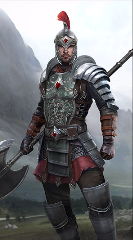
Imperials hail from the region of Cyrodiil, right in the middle of Tamriel. They are called that because in most Elder Scrolls games their homeland is also the seat of the Empire.
The Empire is the third political entity to bear this name in Tamriel’s history. It’s a sophisticated, cosmopolitan society whose seat of power is located in a majestic city and whose hegemony is ensured by a combination of diplomacy, trade, and the military might of its infantry legions. In other words, they are basically off-brand Romans.
Imperial adventurers who hail from the ranks of the legions are most often Knights or battle Wizards. Other popular delver professions are Scholars, Clerics and Bards. The “visiting wise man from Cyrodiil” looking for a lost ruin is common enough to have become something of a cliche.
Traits: Imperials have a reputation for being well-spoken and charismatic. They often have Charisma, Born War Leader, Business Acumen or Smooth Operator, as well as points in the skills boosted by those talents.
Nords
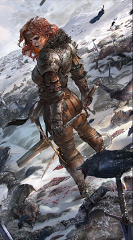
Nords are our off-brand Vikings, as fond of song as they are of fighting. We learned plenty about their homeland of Skyrim in my last post.
The inhabitants of Skyrim have a greater distrust of magic than those of most other provinces, and prefer facing their foes head-on. As such, Knight and Barbarian are some of the most common adventurer professions for them. Bards are also quite popular, both as entertainers and as keepers of history.
Traits: Nord barbarians from Skyrim don’t carry a Social Stigma in campaigns that take place there, and should replace that with 10 points in other disadvantages. Intolerance (Magic Users) or Compulsive Carousing fit the stereotype. Some level of Temperature Tolerance (Cold) isn’t out of place in even the most “urban” Nord.
Redguards
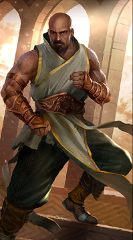
Redguards are tall, well-built humans with dark skin and curly black or red hair. They landed in the arid province of Hammerfell, and made if their home over the centuries. Their culture seems to take inspiration from many different African sources, but ends up looking mostly Moorish, at least superficially.
Redguards are know as the most talented warriors in Tamriel, which is saying a lot given the continent also has Orcs and Nords in it. They make better skirmishers and independent agents than rank and file troops, and during most of the games have a long history of loyal service to the imperial line of Tiber Septim.
Redguard adventurers most often belong to the fightier professions. Swashbucklers and Scouts are the most common, with Martial Artists and Knights following close behind.
Traits: The most iconic Redguard trait is Combat Reflexes! Redguards also prize skill with the sword, so even less martial Redguard adventurers are likely to have some training in that area.
Other Humans
These four human origins are just the ones that are playable in most of the Elder Scrolls games. Several others are mentioned but not traditionally playable:
- The Nedes had a large civilization in the time before the First Age of Tamriel, which entered into decline and was eventually absorbed by several other of the playable cultures.
- The silver-skinned Kothringi of Black Marsh are said to have died out from the Khanaten Flu in the middle Second Age.
- The neighboring continent of Akavir is home to a large human civilization who once successfully invaded and conquered Tamriel, starting its Second Age. In keeping witht he “swipe from real world cultures” theme, the Akaviri are off-brand Imperial Japanese.
Tabletop games set far enough into the past could certainly allow for Nede or Kothringi PCs, and Akaviri PCs would be plausible at almost any time.
-
Sometimes too detailed, in fact. ↩